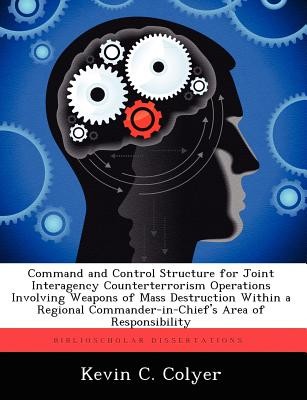
- We will send in 10–14 business days.
- Author: Kevin C Colyer
- Publisher: BiblioScholar
- ISBN-10: 1249364469
- ISBN-13: 9781249364467
- Format: 18.9 x 24.6 x 0.8 cm, softcover
- Language: English
- SAVE -10% with code: EXTRA
Command and Control Structure for Joint Interagency Counterterrorism Operations Involving Weapons of Mass Destruction Within a Regional Commander-In-C (e-book) (used book) | bookbook.eu
Reviews
Description
The threat of state or nonstate actors conducting terrorism utilizing weapons of mass destruction (WMD) against U.S. personnel, property, or other locations of U.S. interest outside the continental U.S. or its territories represents a serious threat to U.S. vital interests. While numerous U.S. government agencies have joined the effort to prepare against this possibility, the system remains disjointed and inefficient. This study presents a command and control structure that meets the requirements of the operation to solve this dilemma. The study first examines the WMD counterterrorism environment and the agencies currently involved to determine what is required to counter the threat. From this a set of command and control criteria is established to compare against current command and control models. The results of comparing the requirements to current models revealed two gaps in the command and control of these operations. The study continues to propose an organizational structure that maintains the strengths of the current system and fills the gaps discovered during the research.
EXTRA 10 % discount with code: EXTRA
The promotion ends in 17d.03:23:23
The discount code is valid when purchasing from 10 €. Discounts do not stack.
- Author: Kevin C Colyer
- Publisher: BiblioScholar
- ISBN-10: 1249364469
- ISBN-13: 9781249364467
- Format: 18.9 x 24.6 x 0.8 cm, softcover
- Language: English English
The threat of state or nonstate actors conducting terrorism utilizing weapons of mass destruction (WMD) against U.S. personnel, property, or other locations of U.S. interest outside the continental U.S. or its territories represents a serious threat to U.S. vital interests. While numerous U.S. government agencies have joined the effort to prepare against this possibility, the system remains disjointed and inefficient. This study presents a command and control structure that meets the requirements of the operation to solve this dilemma. The study first examines the WMD counterterrorism environment and the agencies currently involved to determine what is required to counter the threat. From this a set of command and control criteria is established to compare against current command and control models. The results of comparing the requirements to current models revealed two gaps in the command and control of these operations. The study continues to propose an organizational structure that maintains the strengths of the current system and fills the gaps discovered during the research.


Reviews